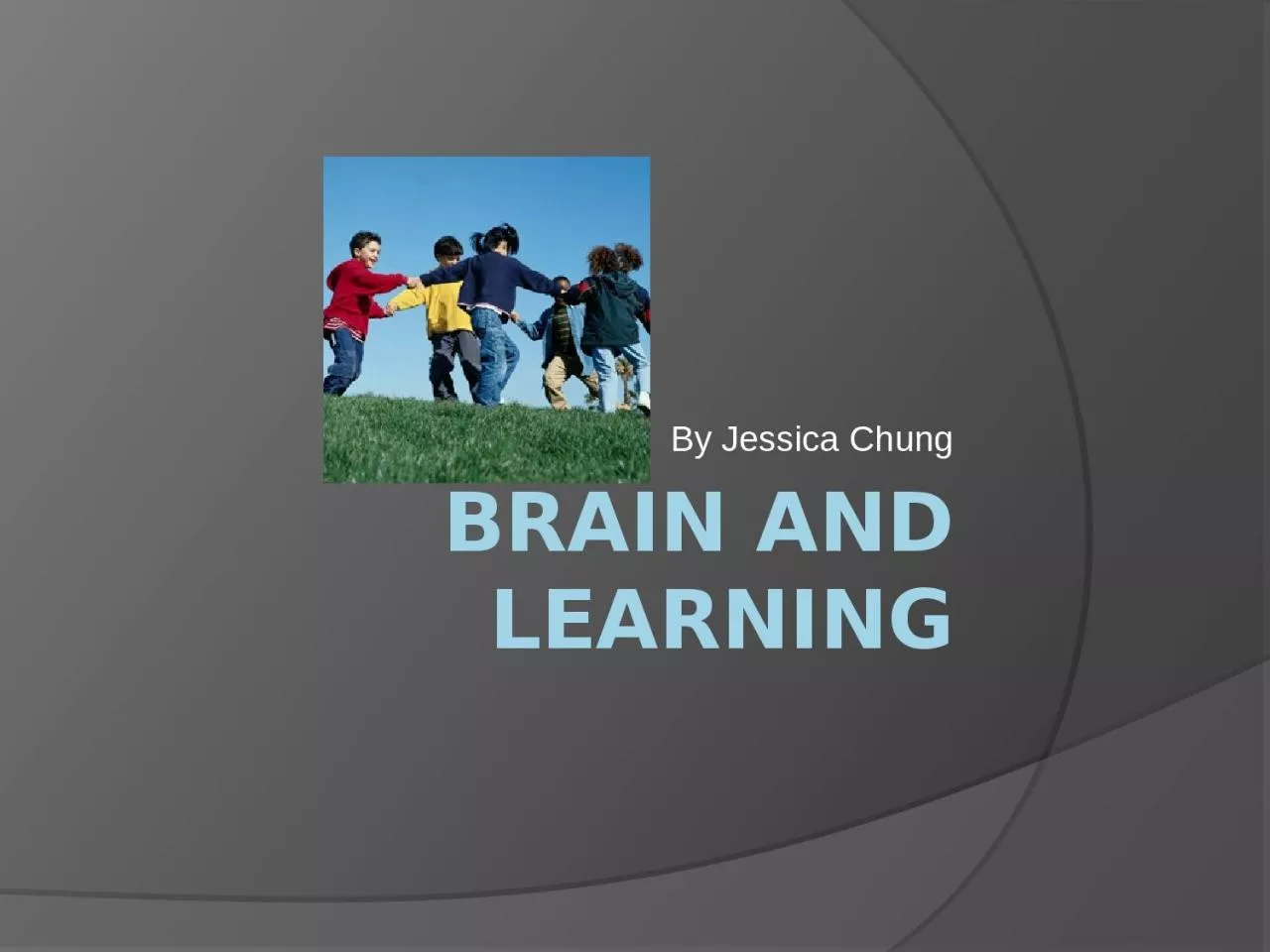

LOOKING INSIDE BRAIN Different techniques XRays CAT scans EEG PET fMRI httpwwwelements4healthcompetscansrevealplaquesandtanglesinalzheimershtml BRAIN ANATOMY 2 types of cells ID: 1048667
Download Presentation The PPT/PDF document "BRAIN AND LEARNING By Jessica Chung" is the property of its rightful owner. Permission is granted to download and print the materials on this web site for personal, non-commercial use only, and to display it on your personal computer provided you do not modify the materials and that you retain all copyright notices contained in the materials. By downloading content from our website, you accept the terms of this agreement.
1. BRAIN AND LEARNINGBy Jessica Chung
2. LOOKING INSIDE BRAINDifferent techniques:X-RaysCAT scansEEGPETfMRIhttp://www.elements4health.com/pet-scans-reveal-plaques-and-tangles-in-alzheimers.html
3. BRAIN ANATOMY2 types of cells:NeuronsGlial cellsNeurons transmit informationGlial cells = helper cellshttp://webspace.ship.edu/cgboer/theneuron.html
4. NEURONS3 Parts:DendritesSomaAxonhttp://gskinner.com/blog/archives/2008/01/elm_tree_branch.html
5. GLIAL CELLSTypes of glial cells:MacrophageObligrodendrocytesAstrocytesSchwann cellshttp://utpa-dcastillo.blogspot.com/2012/09/schwann-cells-to-potentially-cure.html
6. WHAT TAKES PLACE IN SYNAPSE?
7. PARTS OF THE BRAINCortical view:http://en.wikipedia.org/wiki/Functional_specialization_(brain)
8. PARTS OF BRAIN (cont.)Medial/sagittal view:
9. FRONTAL LOBEControls:PlanningVoluntary movementsVerbalizingProblem solvingWillpowerHigher-order thinking
10. PARIETAL LOBEProcesses:Sensory informationWritingReadingLanguageCalculations“WHERE” is it?
11. OCCIPITAL LOBEProcesses vision“WHAT” is it?
12. TEMPORAL LOBEProcesses:HearingLanguageListeningLearningMemory storage
13. LIMBIC SYSTEMContains:ThalamusHypothalamusHippocampusAmygdala
14. HOW BRAIN PROCESSES INFO.Learning, storing, & remembering = dynamic & interactive processhttp://www.breakthroughlearningcollege.com/memory/processing-memory/
15. 4MAT MODELMcCarthy’s 4MAT model = model for teachers to follow in classroomsPeople learn differently & model takes that into considerationhttp://westallen.typepad.com/.a/6a00d8341cad7153ef016306afc956970d-popup
16. HOW TO ENHANCE LEARNINGVisual aids:GraphsPicturesCan greatly increase students’ understanding & retention of information in curriculumhttp://www.presentation-skills.biz/visual-aids/presentation-visual-aids.htm
17. ENHANCE LEARNING (cont.)Auditory aids/music:Music can activate: CognitiveVisualAuditoryAffectiveMotor systems
18. ENHANCE LEARNING (cont.)MovementPhysical exercise improves brain performanceLinked to learning and memoryCerebellum plays important roleRecess gives children different opportunities
19. SOCIAL INFLUENCES – INTRO.Social behavior essential for:ReproductionSurvivalSocial isolation & social separation = risk factors for medical disorders
20. MOTIVATED SOCIAL BEHAVIORSSocial attachmentSocial affiliation Sex behavior Parental care
21. WHAT PARTS OF BRAIN?Occipital temporal junction (especially for facial recognition)Superior temporal sulcus, amygdala, ventromedial prefrontal cortex involvedhttp://www.dana.org/uploadedImages/Images/neuroanatomy_large.jpg
22. WHAT PARTS OF BRAIN? (cont.)Amygdala: recognition of social emotions & perception of fearVentromedial prefrontal cortex = pleasantness, social judgment, and processing of social vocalizations in nonhuman primatesStriatum, medial insula, anterior cingulate cortex in romantic attachment
23. HUMAN VS. MACHINESocial interaction & social setting criticalInfants learn language betterDVDs & CDs not as effectiveSocial cues highlight what to learn & whenStudents learn better face to facehttp://acecec.blogspot.com/
24. SOCIAL BEHAVIOR DEVELOPMENTInfants can learn languageLearning trajectories influenced before going to schoolAdolescents still developing in brainSelf-awarenessSocial cognitive skills
25. ENVIRONMENT STIMULIOutdoor play importantCognitive benefits: awareness, reasoning, observation skills, creativity, concentration, and imaginationPhysical benefits: coordination, balance, & agilityHealth benefits: reduced sickness & speedier recovery
26. ENVIRONMENTAL STIMULI (cont.)No contact leads to:Diminished sensesAttention difficultiesDisassociation from nature
27. BENEFITS OF OUTDOOR PLAYDiverse play behavior:LearningProblem solvingDeveloping social competenceLearning risk managementRich setting for imagination & fantasyhttp://www.playingiseducational.info/outdoor-play-structures/134-choosing-stain-to-maintenance-your-wooden-outdoor-play-structures/
28. 3 SOCIAL SKILLSImitationAccelerates learningFaster than individual discoverySafer than trial-and-error learningChoose whom, when, & what to imitate, mixed with self-discoveryhttp://www.forumjournal.org/site/issue/15
29. 3 SOCIAL SKILLS (cont.)Shared Attention:Same object/event = common ground for communication & teachingEx. Infant head turningInterpret behavior & experience of others based on personal experience
30. 3 SOCIAL SKILLS (cont.)Empathy & Social Emotions:Critical in understandingEx. Toddlers show empathy towards adults in painOverlap in neural systems (seeing painful stimulus vs. receiving painful stimulus)
31. BENEFITS OF INTERACTIONLong-term improvements in:Academic achievementSocial adjustmentEconomic successhttp://www.edutopia.org/blog/improving-academic-achievement-disadvantaged-maurice-elias
32. REFERENCESBlakemore, S. J. (2010). The developing social brain: Implications for education. Neuron, 65, 744–747.Dowdell, K., Gray, T., & Malone, K. (2011). Nature and its influence on children's outdoor play. Australian Journal of Outdoor Education, 15(2), 24-35.Insel, T. R., & Fernald, R. D. (2004). How the brain processes social information: Searching for the social brian. Annu. Rev. Neurosci., 27, 697-722.Kuhl, Patricia. (2011). Early language learning and literacy: Neuroscience implications for education. Mind Brain Educ. 5(3): 128–142. doi:10.1111/j.1751-228X.2011.01121.x.Meltzoff, A. N., Kuhl, P. K., Movellan, J., and Sejnowski, T. J. (2009). Foundations for a new science of learning. Science. 325(5938): 284-288.Nicoll-Senft, J. M., & Seider, S. N. (2010). Assessing the Impact of the 4MAT Teaching Model Across Multiple Disciplines in Higher Education. College Teaching, 58(1), 19-27. Sousa, D. A. (2011). How the brain learns. Corwin Press.Tatar, E., & Dikici, R. (2009). The effect of the 4MAT method (learning styles and brain hemispheres) of instruction on achievement in mathematics. International Journal of Mathematical Education In Science And Technology, 40(8), 1027-1036.Wolfe, P. (2010). Brain matters: Translating research into classroom practice. Association for Supervision & Curriculum Development.